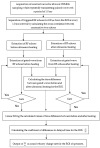Ultrasonic Heating Detects Lipiodol Deposition within Liver Tumors after Transarterial Embolization: An In Vivo Approach
- PMID: 34571777
- PMCID: PMC8466351
- DOI: 10.3390/biology10090901
Ultrasonic Heating Detects Lipiodol Deposition within Liver Tumors after Transarterial Embolization: An In Vivo Approach
Abstract
Computed tomography (CT) is the standard method to evaluate Lipiodol deposition after transarterial embolization (TAE) for a long period. However, iodine but not Lipiodol can be observed on CT. A minimally invasive other method to detect Lipiodol has been needed to evaluate accurate evaluation after procedure. The purpose of this study was to evaluate the efficacy of using the rate of change in sound velocity caused by ultrasonic heating to reflect Lipiodol accumulation after TAE in a rat liver tumor model. We analyzed the association of this developed technique with CT images and histological findings. Eight rats bearing N1S1 cells were prepared. After confirmation of tumor development in a rat liver, Lipiodol was injected via the hepatic artery. Seven days after TAE, CT scan and sound velocity changes caused by ultrasonic heating were measured, and then the rats were sacrificed. An ultrasonic pulse-echo method was used to measure the sound velocity. The temperature coefficient of the sound velocity in each treated tumor was evaluated and compared with the mean CT value and the histological Lipiodol accumulation ratio. Pearson's correlation coefficients were calculated to assess the correlation between the measured values. The correlation coefficient (r) of the mean CT value and histological Lipiodol accumulation ratio was 0.835 (p = 0.010), which was considered statistically significant. Also, those of the temperature coefficient of the sound velocity and the histological Lipiodol accumulation ratio were statistically significant (r = 0.804; p = 0.016). To our knowledge, this is the first study that reported the efficacy of ultrasonic heating to detect Lipiodol accumulation in rat liver tumors after TAE. Our results suggest that the rate of change in sound velocity caused by ultrasonic heating can be used to evaluate Lipiodol accumulation in liver tumors after TAE, and thus could represent an alternative to CT in this application. This new innovative technique is easy to treat and less invasive in terms of avoiding radiation compared with CT.
Keywords: Lipiodol; TACE; TAE; liver tumor; temperature coefficient of the sound velocity; ultrasonic heating.
Conflict of interest statement
The authors declare no conflict of interest.
Figures







Similar articles
-
Optimal lipiodol volume in transcatheter arterial chemoembolotherapy for hepatocellular carcinoma: study based on lipiodol accumulation patterns and histopathologic findings.Semin Oncol. 1997 Apr;24(2 Suppl 6):S6-61-S6-70. Semin Oncol. 1997. PMID: 9151919
-
Transarterial injection of (131)I-lipiodol, compared with chemoembolization, in the treatment of unresectable hepatocellular cancer.J Nucl Med. 2009 Jun;50(6):871-7. doi: 10.2967/jnumed.108.060558. Epub 2009 May 14. J Nucl Med. 2009. PMID: 19443599
-
Effectiveness of hepatic arterial embolization on radiofrequency ablation volume in a swine model: relationship to portal venous flow and liver parenchymal pressure.J Vasc Interv Radiol. 2008 Nov;19(11):1646-51. doi: 10.1016/j.jvir.2008.08.015. J Vasc Interv Radiol. 2008. PMID: 18954767
-
Effectiveness of Transarterial Embolization in Treatment of Symptomatic Hepatic Hemangiomas: Systematic Review and Meta-analysis.Cardiovasc Intervent Radiol. 2021 Jan;44(1):80-91. doi: 10.1007/s00270-020-02611-5. Epub 2020 Aug 17. Cardiovasc Intervent Radiol. 2021. PMID: 32808203
-
Transarterial (chemo)embolisation versus no intervention or placebo for liver metastases.Cochrane Database Syst Rev. 2020 Mar 12;3(3):CD009498. doi: 10.1002/14651858.CD009498.pub4. Cochrane Database Syst Rev. 2020. PMID: 32163181 Free PMC article.
References
-
- Satake M., Uchida H., Arai Y., Anai H., Sakaguchi H., Nagata T., Yamane T., Kichikawa K., Osaki Y., Okazaki M., et al. Transcatheter Arterial Chemoembolization (TACE) with Lipiodol to Treat Hepatocellular Carcinoma: Survey Results from the TACE Study Group of Japan. Cardiovasc. Interv. Radiol. 2008;31:756–761. doi: 10.1007/s00270-007-9255-7. - DOI - PubMed
Grants and funding
LinkOut - more resources
Full Text Sources
Miscellaneous

